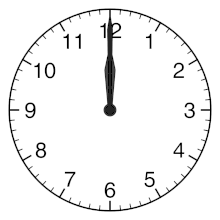Hour
A hour is a unit of time that corresponds to one twenty-fourth of a mean solar day.
This is used for civil time and is 60 minutes or 3600 seconds, although small irregularities in the Earth's rotation make adjustments necessary. Since since 1967 the second has been measured based on very precise atomic properties, leap seconds are used to maintain time standards close to the mean solar day.
A watch is made up of 2 or 3 hands: the second hand (the second hand) makes 1 revolution in 1 minute, the minute hand (the large hand) makes 1 revolution in 1 hour (60 min), and the hours (the small hand) 1 revolution in 12 hours.
In Spanish the term hora does not have an abbreviation, but it is used as an indication of the moment in which something happens or is done in relation to each of the twenty-four parts into which the time is divided. day and is written with figures, optionally the symbol h can be used, and in that case it must be written without a point and it is invariable in the plural. However, in American countries that have Spanish as their language Mainly, it is common for them to use the 12-hour system, that is, divide the 24 hours into 12 hours; For example, instead of 01:00, it will be 1:00 AM. m., instead of 1:00 p.m. it will be 1:00 p.m. m., although it is used to indicate a singular.
Hour is the twelfth part of the time that elapses from sunrise to sunset. The Egyptians divided the day into twenty-four hours, twelve with sunlight and twelve at night, it would be this system that the Greeks and Romans adopted. The latter first applied the system of twelve daytime hours and later to the calculation of the night, the time elapsed from sunset to sunrise, was also divided into twelve hours. This type of hours was measured by a sundial or by a Clepsydra. When a mechanical clock uses these hours, its speed must be changed every morning and evening, for example by changing the length of its pendulum. The time according to this definition is regulated according to the Temporary Time System.
Time, in turn, can be measured through the use of a clock. The purpose of establishing a schedule, for example, is to indicate the precise moment in which a future event will take place so that people can organize their routine.
Later, it was defined as the twenty-fourth part of the apparent solar day, the period between one noon and the next, or between one sunset and the next. In this definition the hours vary somewhat, since the length of the apparent solar day varies throughout the year. When a watch uses these hours, it must be adjusted a few times during the month. Depending on whether the passage of the Sun through sunset or sunrise is taken as the origin, it will be called the Italic Time System or the Babylonian Time System, respectively.
Time zones
The hour is also an angular measure: the Earth makes one revolution on itself in approximately 24 hours, one hour equals 15° (that is, one twenty-fourth part of the circumference). In every terrestrial meridian the passage of the Sun occurs at noon; an hour later it will pass through another meridian located 15° west of the first and so on until midnight, at which precise moment it will be in the antemeridian of the origin meridian. From then on, the Sun approaches it from the east, until it returns to the initial point 24 hours later.
Now, given the spheroidal shape of the terrestrial globe, the surface limited by two meridians separated by the angular distance of 15° has the shape of a spindle. By universally adopted convention, all clocks located within the same time zone indicate the same time, although this rule necessarily has certain exceptions. Thus, when a relatively small part of a country is outside the zone, it is considered (to standardize the national time) that the entire territory is in the main zone. In very large countries from east to west, such as the Russian Federation, Canada or the United States, there is no one national time, but rather as many hours as there are time zones that cross the territory. Or in other cases, a part of a country can be subject to a schedule, such as the Mexican state of Sonora, which never changes its schedule and maintains the same time as its neighboring border state of Arizona.
Time difference by seasons of the year
Certain countries, taking advantage of the fact that the Sun sets later in summer, institute the so-called summer time a few months a year, that is, they advance all clocks by one hour, which is equivalent to adopt the time of the neighboring zone located to the east. In the same way, in winter it returns to the original time zone to make the most of the luminosity of the Sun. In the European Union this change takes place on the same day for all Member States.
In other cases, geopolitical reasons encourage a country to permanently adopt the time corresponding to the neighboring zone: Spain, located in zone 0, changed to the time of zone 1 (CET time), in order to facilitate relations with the Western and Central part of the European Union.
Exact time
Knowing the time has many repercussions, it is very important in astronomy and in other fields of human activity. For this reason, there are international and national services in charge of keeping an exact time and disseminating it to users. For a long time, the task of determining the time was carried out by astronomers who based themselves on the movements of the stars. Today, atomic clocks are used to indicate time with enormous precision.
The exact and official time in Spain is kept according to the atomic clock of the Royal Institute and Navy Observatory (ROA) of San Fernando (Cádiz).
In Mexico, the official time is determined by the National Metrology Center (CENAM), under the Ministry of Economy.
In Chile, the official time is determined by the Hydrographic and Oceanographic Service of the Chilean Navy (SHOA).
In Colombia, the official time is determined by the National Institute of Metrology of Colombia.
In Costa Rica, the official time is determined by the National Meteorological Institute of Costa Rica (IMN).
Expressions related to time
- Last hour. At the last moment.
- Good hours green sleeves. It is usually used to prove that someone has done something without due opportunity.
- Congratulations. Felicitation from In good time.
- Bad time. Bad timing.
- Canonical hours. The different parts of the office that the church usually prays in different hours of the day. They are: maitines, laudes, prima, tercia, sixth, nona, eves and complete.
- Less hours. The canonicals of prima, tercia, sixth and nona that are uniformly composed of a hymn of three psalms, a chapter, a responsorio and a prayer.
- Dead hours. The many hours lost in a single routine occupation.
- Get him to one his time. Die.
- Born in good or bad time. Be blissful or misleading.
- He didn't win Zamora in an hour.. It indicates that you need to be patient.
- Don't see one the time to do something.. Be willing to do it.
- I count the hours for it to happen. Waiting for something to happen soon.
- Have one your hours counted. Be close to death.
- It's time.. It says something should have happened before.
- Give me time.. Expression that is used to order appointment.
- The hour of truth. Definitory moment in which hidden events are revealed, they come to an end.
- It doesn't even touch quarts or hors (catalan). Be crazy.
Equivalences of other time units in hours
- One day is 24 hours
- A week is 168 hours
- A month is 744 hours
- One year is 8760 hours and 8784 hours in the bisister year
- A multiple century of 4 (like the 20th century) has 876 600 hours
- A non-multiplo century of 4 (like the nineteenth century) has 876 576 hours. This is because in the Gregorian calendar the years ended in 00 are only bisies if they are multiples of 400. Thus, 2000 was bisister, but 1900 was not.
- One millennium is 8 760 000 hours.
Additional bibliography
- Baxter, William H. et al. (2014), Old Chinese: A New Reconstruction (in English), Oxford: Oxford University Press., available in part here [1].
- Clagett, Marshall (1995), Ancient Egyptian Science, Vol. II: Calendars, Clocks, and Astronomy, Memoirs of the APSNo. 214 (in English), Philadelphia: American Philosophical Society, ISBN 9780871692146..
- Dershowitz, Nachum et al. (2008), Calendrical Calculations (in English), Cambridge: Cambridge University Press, ISBN 9780521885409..
- Holford-Strevens, Leofranc (2005), The History of Time: A Very Short Introduction, Very Short Introductions, Vol. 133 (in English), Oxford: Oxford University Press, ISBN 9780192804990, (requires registration)..
- Landes, David S. (1983), Revolution in Time (in English), Cambridge: Harvard University Press..
- Parker, Richard Anthony (1950), The Calendars of Ancient Egypt, Studies in Ancient Oriental CivilizationNo. 26 (in English), Chicago: University of Chicago Press..
- Petersen, Jens Østergård (1992), «The Taiping Jing and the A.D. 102 Clepsydra Reform, Acta Orientalia (in English) 53, Copenhagen, pp. 122-158..
- Rogers, J.H. (1998), “Origins of the Ancient Constellations”, Journal of the British Astronomical Association, No. 108 (in English), London: BAA..
- Sewell, Robert (1924), The Siddhantas and the Indian Calendar (in English), Kolkata: Government of India Central Publication Branch, ISBN 9788120603646..
- Sōma, Mitsuru et al. (25 October 2004), «Units of Time in Ancient China and Japan», Publications of the Astronomical Society of Japan, Vol. 56, No. 5 (in English) 56 (5), Tokyo: ASJ, pp. 887-904, doi:10.1093/pasj/56.5.887..
- Steele, J.M. (2000), Observations and Predications of Eclipse Times by Early Astronomers (in English), Amsterdam: Kluwer Academic Publications..
- Stephenson, F. Richard (1997), Historical Eclipses and Earth's Rotation, Cambridge: Cambridge University Press..
- Stephenson, F. Richard et al. (2002) Historical Supernovae and Their Remnants (in English), Oxford: Oxford University Press, ISBN 978-0-19-850766-6..
- Thongprasert, Chamnong (1985), « pretending to be the owner- wing of the trade- eagerness to imagine what happened [Thum-Mong-Nalika]», precipitous fiscal brain oriented oriented oriented [Thai Unlocked], Bangkok: Prae Pitaya Press.. (in Thai)
- Wall, J. Charles (1912), Porches " Fonts (in English), London: Wells, Gardner, Darton & Co..
- Wilkinson, Richard H. (2003), The Complete Gods and Goddesses of Ancient Egypt (in English), Singapore: Tien Wah Press for Thames " Hudson..
Contenido relacionado
Partial pressure
Confounding factor
Niobium


